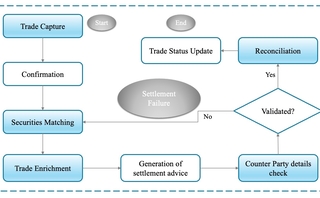BoE model risk rule may drive real-time monitoring of AI
New rule requires banks to rerun performance tests on models that recalibrate dynamically.

New rules from the Bank of England (BoE) on model risk management could push banks towards much more intensive monitoring of artificial intelligence (AI) and other algorithms that dynamically recalibrate, experts say.
“Algos and AI continuously operate, so it’s necessary to ensure they behave as expected, and that puts lots of pressure on us,” says Karolos Korkas, head of algorithmic trading model risk at Nomura. “We might just need to move into more real-time monitoring.”
The BoE’s Prudential Regulation Authority published its final supervisory statement, SS1/23, in May this year, following a consultation in June 2022. The PRA noted respondents to the original consultation had expressed concern that the requirement to rerun performance tests on models with “dynamic calibration would be computationally intensive and may not be practical across all model types, e.g., algorithmic trading and other pricing models”. But the regulator decided to stick to its guns in the final version of the rules.
“The PRA expects firms to manage the risk that a series of small (immaterial) changes due to recalibrations could accumulate, when uncontrolled or unchecked, into a material change in the model output over time without it being tested,” the PRA concluded.
The sheer volume of data that drives some of these models would make it, if not computationally intensive, then certainly effort intensive to try to figure out how you rewind back to earlier periods
Rod Hardcastle, Deloitte
These are not the first regulatory requirements around models, but, before SS1/23, PRA guidance has been piecemeal and incorporated into other parts of the risk taxonomy. The new rule offers an overarching model risk guidance, and places clear management responsibility on both model users and the board, integrating the requirements into the UK senior managers’ regime.
“How do we explain the models, how do we understand the models, how do we collect the data, how do we monitor them?” says Korkas. “We need to be very cautious about how we scale up the whole AI technology.”
Crucially, the rule also provides a new, very broad definition of models: “The definition of a model includes input data that are quantitative and/or qualitative in nature or expert judgement-based, and output that are quantitative or qualitative.”

Bankers believe this will vastly increase the model inventory for many banks, stretching validation teams and potentially forcing a cull of models if their use case is inadequate.
The adoption of AI throughout banks in a wide range of functions in recent years presents a further challenge. Whereas models for calculating regulatory capital have already been subject to supervisory validation processes for many years, some AI activity has not been explicitly covered by any existing regulation. Sources mention programs to assist retail loan underwriting decisions and to help human resources departments sift the CVs of job applicants as areas where AI has faced less internal and external scrutiny.
“AI models might have been sold to people in the organizations who aren’t experienced model owners, and they might not even realise that they’re buying an AI product,” says Keith Garbutt, an independent consultant, and former head of model validation at HSBC.
Rewriting history
The fear around implementing the “automatic recalculation of performance test results” for AI stems from the fact that the technology makes decisions via many small changes in the model, which can happen without input from the model owner.
Existing prudential models that are operated and calibrated by risk managers tend to be reviewed every quarter and validated only once or twice a year. An AI model, however, changes independently of the model operator. For example, if the model is used for anti-money laundering transaction monitoring and trained on unsupervised data, it will teach itself how to distinguish suspicious or normal transactions.
The changes in its behavior and decision-making might not be triggered by events such as new regulations, but rather by its own success at flagging suspicious transactions. In this specific example, the model will also be running on a very large amount of data. The more data it ingests, the more likely it is to change its logic and decision-making.
Algos and AI continuously operate, so it’s necessary to ensure they behave as expected, and that puts lots of pressure on us. We might just need to move into more real-time monitoring
Karolos Korkas, Nomura
Performance tests would have to track the history of each of those decisions, and the implications for overall model accuracy. The longer the time lag between each test, the more potential model changes will have taken place, which means the standard quarterly monitoring may not be enough.
“The sheer volume of data that drives some of these models would make it, if not computationally intensive, then certainly effort intensive to try to figure out how you rewind back to earlier periods,” says Rod Hardcastle, head of credit risk regulation at Deloitte, and a former head of prudential risk at the Bank of Ireland.
All of this points to much more frequent monitoring of AI to track any automated changes in the model. For more material models, that might mean a kill switch where appropriate and applicable. Such is the case for dynamically recalculating algo trading models, says Andrew Mackay, former head of model risk at Deutsche Bank.
Nadia Bouzebra, head of model risk at Close Brothers, explains that some models can be tested once at the beginning of their lifecycle, and then an easy retest can be done at a set periodicity. But some need to be monitored every single day.
Benchmarks and key performance indicators are used to ensure models don’t stray from their expected outputs, says Bouzebra. This is another part of governance that will have to be firmly enforced under the new PRA rules, with contingency plans for models that cannot be adequately monitored or fail the tests.
“If you want to use those models, there are things you need to do to ensure they are working properly,” says David Asermely, global head of risk management at technology vendor SAS. “If you are not able to do those things, then maybe you need to use something else—do you have a bunch of challenger models that can replace it?”
Saving graces
Several elements of the PRA rule will make it easier for firms to comply. First, SS1/23 will not apply to banks on the PRA’s simpler firms regime—for which the BoE intends to develop similar rules at a later date. For the banks covered by SS1/23, the compliance date is May 2024.
Second, the requirements also include a tiering process, where the required rigor of model risk management depends on the materiality of risk that each model represents for the bank. Realistically, bankers say the highest tiers are likely to comprise models that are already subject to significant scrutiny, such as those used for calculating regulatory capital.
“Will it be challenging? Yes, but it’s not a new problem,” says Mackay.
For global banks, there is a further source of reassurance: the PRA guidance has some elements in common with US model risk rules set out more than a decade ago by the Federal Reserve and the Office of the Comptroller of Currency in SR 11-7. However, the US rules did not cover AI, since its adoption was much less widespread and has accelerated sharply in recent years.
“If you’ve been through SR 11-7, you can’t just assume you will be compliant with the [PRA] principles,” says Hardcastle.
Moreover, Mackay notes that some non-US banks still struggle to comply with SR11-7 even today. The model risk managers speaking to WatersTechnology’s sibling publication Risk.net give estimates of anywhere between two and five years for banks to bring their processes up to a level that is likely to pass muster with the BoE, depending on how strict the regulator chooses to be.
“The key factor for me is the tone from the top, whether the boards—management and supervisory—can understand the benefits of compliance and costs of non-compliance,” says Mackay.
Further reading
Only users who have a paid subscription or are part of a corporate subscription are able to print or copy content.
To access these options, along with all other subscription benefits, please contact info@waterstechnology.com or view our subscription options here: http://subscriptions.waterstechnology.com/subscribe
You are currently unable to print this content. Please contact info@waterstechnology.com to find out more.
You are currently unable to copy this content. Please contact info@waterstechnology.com to find out more.
Copyright Infopro Digital Limited. All rights reserved.
You may share this content using our article tools. Printing this content is for the sole use of the Authorised User (named subscriber), as outlined in our terms and conditions - https://www.infopro-insight.com/terms-conditions/insight-subscriptions/
If you would like to purchase additional rights please email info@waterstechnology.com
Copyright Infopro Digital Limited. All rights reserved.
You may share this content using our article tools. Copying this content is for the sole use of the Authorised User (named subscriber), as outlined in our terms and conditions - https://www.infopro-insight.com/terms-conditions/insight-subscriptions/
If you would like to purchase additional rights please email info@waterstechnology.com
More on Emerging Technologies
Quants look to language models to predict market impact
Oxford-Man Institute says LLM-type engine that ‘reads’ order-book messages could help improve execution
The IMD Wrap: Talkin’ ’bout my generation
As a Gen-Xer, Max tells GenAI to get off his lawn—after it's mowed it, watered it and trimmed the shrubs so he can sit back and enjoy it.
This Week: Delta Capita/SSimple, BNY Mellon, DTCC, Broadridge, and more
A summary of the latest financial technology news.
Waters Wavelength Podcast: The issue with corporate actions
Yogita Mehta from SIX joins to discuss the biggest challenges firms face when dealing with corporate actions.
JP Morgan pulls plug on deep learning model for FX algos
The bank has turned to less complex models that are easier to explain to clients.
LSEG-Microsoft products on track for 2024 release
The exchange’s to-do list includes embedding its data, analytics, and workflows in the Microsoft Teams and productivity suite.
Data catalog competition heats up as spending cools
Data catalogs represent a big step toward a shopping experience in the style of Amazon.com or iTunes for market data management and procurement. Here, we take a look at the key players in this space, old and new.
Harnessing generative AI to address security settlement challenges
A new paper from IBM researchers explores settlement challenges and looks at how generative AI can, among other things, identify the underlying cause of an issue and rectify the errors.







